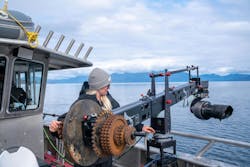“Incredible Animal Journeys”: How Did NatGeo Track and Film Those Migrations?
What you’ll learn:
- An inside look at the “Incredible Animal Journeys” docuseries.
- The technologies used, from drones to biologgers, to capture images and video.
It’s a scene in nature most people have never witnessed: A massive humpback whale giving birth in the Atlantic Ocean, which she then shepherded from Hawaii to Alaska, a trip just over 3,000 miles. The scene is so rare that the scientists who captured the event called it the “Holy Grail,” and it became the focal point of the first episode of National Geographic’s new “Incredible Animal Journeys” docuseries.
The series follows the migration of animals from all over the globe, spanning seven continents and filmed over a three-year period. These amazing travelers brave extreme cold, sweltering deserts, seas, and mountains, which are navigated using the Earth’s magnetic field, stars, moon, ocean currents, and natural senses to migrate over long distances.
The latest technologies have given viewers a unique perspective, an intimate view of nature’s beauty captured in high definition on a scale never before envisioned with early documentary nature shows such as “Wild Kingdom,” “Nature,” and “Under Sea World” (Jacques Cousteau). That evolution in technology mirrors the broader advances made in filmmaking and exploration.
From the early days of grainy images capturing wildlife in its raw form, technology has propelled nature documentaries into a realm of clarity and detail. HD cameras, drones, trail cameras, and specialized imaging systems now enable filmmakers to capture the intricacies of nature.
Satellites Plus Biologgers Add a New Dimension
Making “Incredible Animal Journeys” wouldn’t be possible without another piece of technology that we use on a daily basis, even to watch this incredible series—satellites. Certain shots in the series show possible migration paths of the animals on a globe done using localization satellites and the Argos system (Fig. 1), which collects, processes, and disseminates environmental data from fixed and mobile platforms around the world.
The system can geographically locate a data source from any location on Earth using the Doppler effect, which is the same system that tracks weather in real-time. Those data sources can also be in the form of tags affixed to some animals.
“The Argos satellite system, in particular, stands out for its capability to connect with incredibly small transmitters, a technology we've actively contributed to in collaboration with scientists,” said Kimberly Jeffries, cinematographer and underwater camera person of the series. “This system has been instrumental in wildlife research and protection efforts. The tags we helped develop, when affixed to animals, allow for real-time tracking, enabling us to capture vital data that sheds light on changes and behavior patterns.”
The number of animals outfitted with the Argos tags, or biologgers, is over 300,000. On a monthly basis, around 8,000 animals are monitored, which allowed the production team to capture a diverse range of behaviors and movements. The amount of data collected by those tags is enormous, enabling the team to gain insight into animal behaviors, migration patterns, and responses to environmental changes.
Advanced Cameras
Of course, you can’t have a nature series without cameras, and NatGeo and the cinematographers employ an extensive array of specialized imaging systems for nearly every environment, including underwater where light and biomatter dictate what can be used.
“In our underwater cinematography, we strategically opt for RED cameras due to their outstanding detail resolution and the capability to shoot at high frame rates,” said Jeffries. “These cameras, paired with GATES housings for divers, are instrumental in capturing the intricate beauty of underwater environments with unparalleled clarity. GATES housings not only safeguard the cameras in challenging aquatic conditions, but also provide a seamless interface for operational control and stability.”
Moreover, the team deployed a specialized retractable pole cam system (Fig. 2) to capture aquatic life, using a vertical wing of sorts that diffuses water pressure when affixed to a boat, allowing the team to keep pace with whales and other life without distorting the images and video.
Customized 4K tags, which were affixed to whales and tiger sharks, measured everything from depth to speed, as well as GPS and VHF radio for easy tracking and location data. They also provided a bird’s-eye view of aquatic phenomena, including bubble net feeding in Alaska and the mother-calf whale interactions highlighted in the first episode.
Bubble-Free Rebreathers
Filming the whales in their environment (Fig. 3) was a tricky endeavor for the team, more so when giving birth as the divers didn’t want to pose a risk to the mother. To capture that unique footage, the divers chose to go with rEvo closed-system rebreathers over traditional oxygen/nitrogen tanks, as the former doesn’t exhale gas and create bubbles, which could startle the whales.
“In contrast to traditional open-circuit scuba gear or freediving, closed-circuit rebreathers played a crucial role in our approach, by providing a silent and bubble-free diving experience,” said Jeffries. “This not only allowed us to immerse ourselves in the underwater world without disrupting natural behaviors but also presents distinct advantages physiologically for divers. The closed-circuit rebreathers became an indispensable tool, extending our time underwater and facilitating our mission to document and understand the intricacies of marine life with minimal interference.”
The advent of the latest technologies has revolutionized the filming of wildlife in their natural habitats, and it’s provided insight into their migration patterns. Drones have provided incredible aerial views without disturbing the animals, offering unique perspectives of their daily lives, while tracking tags and satellites allow researchers to see the natural progression of migration routes.
Such technologies not only heighten the quality of wildlife documentaries, but they also contribute to scientific understanding and conservation efforts, providing a profound connection between viewers and the wonders of the animal kingdom.




